Seahorses
The oddly shaped and upright-swimming seahorse seems an unlikely fish. Yet more than 45 species live in coastal waters around the globe. Scientists have learned their basic biology, but much remains unknown about these charismatic animals.
Its head may resemble a horse’s, but each seahorse has a look all its own. Most are spotted, speckled, or striped, and some are decked out in skin frills, spikes, and crowns. Colors vary and can change with the twitch of a muscle to offer camouflage or to signal a foe or potential mate.
Seahorses have flesh-covered bony plates instead of scales, eyes that work independently of each other, and prehensile tails—used to grip holdfasts on the seafloor to avoid drifting and, during courtship, to link to each other.
The tiniest species is no bigger than a lima bean; the largest can reach more than a foot from head to tail tip.
Habitat and movement
Preferring calm, shallow waters, seahorses thrive in seagrass beds, mangroves, estuaries, and coral reefs in temperate and tropical waters around the world. Relatively inept swimmers, the fish get around with frantic beats (up to 70 times per second) of a dorsal (back) fin and rely on tiny pectoral fins for stability and steering. Easily exhausted, many are swept away in heavy currents or killed in storm-roiled seas.
Seahorses are ambush predators: They hold still and wait for krill, copepods, fish larvae, and other tiny edibles to float by and then nab them with remarkable speed. Toothless and lacking a stomach for food storage, the animals use their long snouts like vacuum cleaners to suck up plankton nearly continually.
What Do Seahorses Eat? Diet And Nutrition Explained
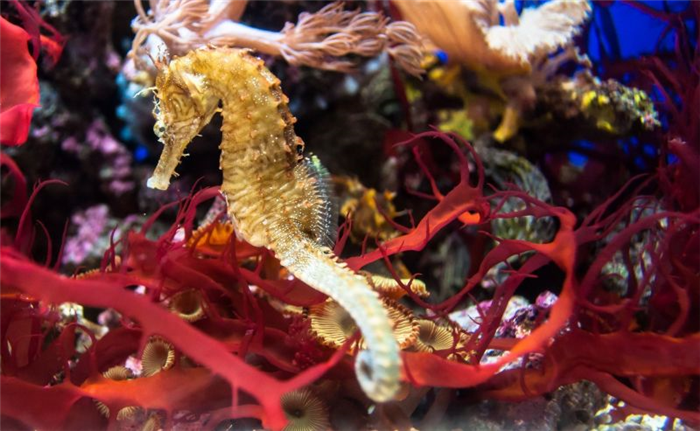
Show all photos 1
Published on Oct 29, 2021
Get inspiration for education!
Subscribe for virtual tools, STEM-inspired play, creative tips and more
Seahorses are one of the most distinct-looking sea creatures living in the shallow seas.
It is interesting to know that seahorses sleep with open eyes as they do not possess eyelids. Their eyes move independently of each other, resembling a chameleon.
The seahorse is a fish belonging to the category of bony fish, though they do not have scales like fish. They breathe with their gills. Seahorse belongs to the genus Hippocampus, in the animal kingdom. The word Hippocampus originates from Greek. Hippo means horse, and campus means sea monster.
Seahorses are found mostly in shallow temperate and tropical saltwater, ocean habitat around the world. They live in sheltered regions like coral reefs, seagrass beds, mangroves, and estuaries. The size of an adult seahorse can range from less than an inch to almost 14 in (25 cm) with 46 different species. These animals have a head and neck similar to a horse and are named for their equine appearance.
With a long-snouted head and bent neck, their trunk and tail look very distinct. Surprisingly, though they are bony fish, they do not possess scales but have a series of bony plates arranged throughout the body with thin skin. These bony plates act as protective organs against predators. Seahorses are experts in camouflaging and can absorb and regrow the spiny appendages based on their living habitat. The neck is flexible and well-defined, sports a coronet, a crown-like horn, which is distinct to each of its species.
Another fascinating fact about seahorses is that they change colors and camouflage themselves to blend in the background color to protect themselves. Seahorses do this to communicate and express emotions, especially during courtship.
The courtship happens for several days before mating, extending over four stages. During courtship, they change color and swim together side-by-side, which is called the pre-dawn dance. Eventually, they engage in a true courtship dance, when the female lays dozens of thousands of eggs in the male’s abdominal pouch. Then the male discharges its sperm into the pouch to fertilize the female’s eggs. The gestation period is two to four weeks. These eggs remain in the male’s pouch for 20 to 45 days to adjust to the salinity of brine for incubating and giving birth to the young seahorses.
You can learn more such fun facts like what do frogs eat? and what do iguanas eat? on our website Kidadl.
What do seahorses eat in captivity?
Unlike most other aquatic animals, adult seahorses do not have teeth. They simply suck the food through the long snout and swallow it. They also do not have a stomach, so they need to eat many times in the day. Hence, the food they eat in a natural habitat like the ocean is tiny live food such as insects, plankton, baby shrimp, and small fish.
Keeping seahorses in captivity is challenging because they should be kept in a separate salt tank, safely protecting them from getting hurt by other fishes. There is no evidence of seahorses surviving in freshwater. Even Dwarf seahorses are expensive, and having them is a costly affair.
Seahorses need a lot of tiny food as they are continuously feeding. Having them as pets requires a significant investment of time and money, as with any other pet. Seahorses usually eat foods like frozen food, live food, pellets, or flakes while in captivity. Pellets and flakes are mostly alternate foods when live and frozen foods are not available.
Did you know the Chinese once believed that seahorses could be used to treat ailments like wheezing and infertility? Seahorses are popular in some Asian countries as marine food delicacies. Several snack recipes find their place in the cuisines of countries like Taiwan, China, Japan. They are also used for ornaments. Due to these reasons, several million seahorses are removed from the oceans and traded for values as high as gold or silver. Apart from this, habitat threats due to industrialization and pollution have caused the seahorses to reduce in numbers, significantly threatening their existence.
What do seahorses eat in an aquarium?
Among all species, the biggest seahorse of the genus Hippocampus is a big-belly seahorse, which can grow up to 15 times that of the smallest species.
Satomi’s pygmy seahorse is the smallest species that can grow up to half an inch in size. This species is nocturnal, which means it is active during the night. All other species are diurnal, stay active during the daytime. It is known that some species of seahorse are monogamous and mate for life, showing high levels of fidelity. However, a few species switch mates when the opportunity arises.
Pipefishes, seadragon, and weedy seadragon belonging to the family Syngnathidae are the closest seahorses’, which are signified by their bony structure and long snouts. They are becoming popular as exotic pets, though maintaining them is an expensive hobby. They can live up to four years when taken care of well.
As a pet, live foods, such as plankton and shrimp, are the perfect type of food for the seahorses in an aquarium. They contain the required nutrition, especially for baby seahorses. Generally, they carry the highest risk of diseases and parasites. It is essential to buy high-quality live food which is free of diseases. They should be sourced from reliable places for safety.
Since live food can be seasonal, switching to frozen food may be required in captivity, especially in winter. Baby shrimps, daphnia, crustaceans, etc., can be an excellent source of frozen food in such an environment. Frozen food can be purchased from a reliable pet store or online.
How often do seahorses eat?
In tropical and temperate brine waters, seahorses eat small crustaceans crawling at the bottom or floating in the water. Tiny crustaceans like amphipods, decapods, mysid shrimp are favorites in their diet. Though the seahorses eat small marine animals, they also feed on plant food in shallow seagrass habitats, seagrass, kelps, algae, larval fish, and other invertebrates.
Most often, once the male seahorse gives birth to the baby seahorses, it eats most of them. Of the hundreds of young seahorses born, only a few survive, and most of them are eaten by the adult male seahorse or sway with the oceanic currents, which their delicate structure cannot survive.
An adult seahorse eats 30-50 times a day to survive as the food quickly passes down the body. They have a very simple digestive system, with no organs like stomach; they continuously have to eat to stay alive.
How do seahorses get their food?
Even adult seahorses are ridiculously slow swimmers, but they ferociously feed on small marine animals and copepods, which are one of the tiny creatures and fastest swimmers. They are considered deadly because they sneak towards their prey with absolutely zero disturbance to their surroundings. Its movement is so sneaky that the copepod cannot sense the danger and falls prey to the seahorse.
Seahorse strikes its prey with almost 90% accuracy, which is why it is considered the ocean’s most ferocious predator and deadliest killer despite not having teeth. The natural shape of the heads and the long snouts aid them in this process. Having simple digestive systems, they eat up to 50 times a day to stay alive.
With the excellent ability to camouflage themselves, they ambush prey floating in seawater, within striking range, patiently waiting for the right moment. They close in on their prey without alerting it and suddenly raise their head to bring the snout close to the prey. This is important because they can only suck the prey from a close range. This two-step prey capturing mechanism is called pivot feeding.
Did you know that seahorses swim upright, unlike many other fishes? They are poor swimmers, and the slowest moving fish in the world is a Dwarf seahorse. Its maximum speed is five feet per hour. Being poor swimmers, they frequently rest, winding their tails around a stationary object. They cling to other entities like corals to camouflage themselves while resting. The long snout helps them suck the food quickly.
Here at Kidadl, we have carefully created lots of interesting family-friendly facts for everyone to enjoy! If you liked our suggestions for what do seahorses eat? Then why not take a look at what do insects eat or lined seahorse facts?
Written By
The Kidadl Team is made up of people from different walks of life, from different families and backgrounds, each with unique experiences and nuggets of wisdom to share with you. From lino cutting to surfing to children’s mental health, their hobbies and interests range far and wide. They are passionate about turning your everyday moments into memories and bringing you inspiring ideas to have fun with your family.
Read The Disclaimer
Disclaimer
At Kidadl we pride ourselves on offering families original ideas to make the most of time spent together at home or out and about, wherever you are in the world. We strive to recommend the very best things that are suggested by our community and are things we would do ourselves – our aim is to be the trusted friend to parents.
We try our very best, but cannot guarantee perfection. We will always aim to give you accurate information at the date of publication – however, information does change, so it’s important you do your own research, double-check and make the decision that is right for your family.
Kidadl provides inspiration to entertain and educate your children. We recognise that not all activities and ideas are appropriate and suitable for all children and families or in all circumstances. Our recommended activities are based on age but these are a guide. We recommend that these ideas are used as inspiration, that ideas are undertaken with appropriate adult supervision, and that each adult uses their own discretion and knowledge of their children to consider the safety and suitability.
Kidadl cannot accept liability for the execution of these ideas, and parental supervision is advised at all times, as safety is paramount. Anyone using the information provided by Kidadl does so at their own risk and we can not accept liability if things go wrong.
Sponsorship & Advertising Policy
Kidadl is independent and to make our service free to you the reader we are supported by advertising.
We hope you love our recommendations for products and services! What we suggest is selected independently by the Kidadl team. If you purchase using the buy now button we may earn a small commission. This does not influence our choices. Please note: prices are correct and items are available at the time the article was published.
Kidadl has a number of affiliate partners that we work with including Amazon. Please note that Kidadl is a participant in the Amazon Services LLC Associates Program, an affiliate advertising program designed to provide a means for sites to earn advertising fees by advertising and linking to amazon.
We also link to other websites, but are not responsible for their content.
What Do Seahorses Eat? 15+ Foods They Crave
Seahorses are one of the most recognizable creatures in the entire world. These fish have a distinct shape that resembles the head and neck of a horse. Seahorses have long snouts and even a prehensile tail that they use to stay anchored in place while looking for food. They vary in size, from less than an inch long to just about a foot in extraordinary cases (the largest seahorse can reach nearly 14 inches long). Their size begs the question, what do seahorses eat?
Fortunately, there are many tiny foods to be found in the ocean! We’ll show you the various meals that seahorses eat along with how they manage to capture foods despite their diminutive size.
What Foods Do Seahorses Eat?
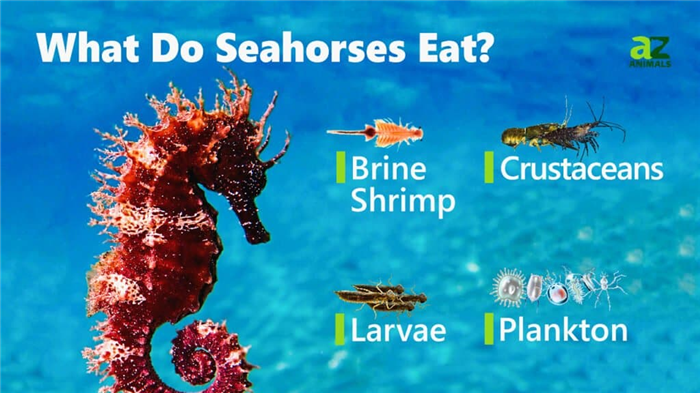
Seahorses eat crustaceans, algae, and plankton.
Seahorses eat crustaceans, phytoplankton, algae, and zooplankton. These fish are omnivores that use their snout to consume their meals. Seahorses have a unique physiology that requires them to eat quite often, albeit in small amounts.
The foods that seahorses are most likely to consume include:
The list of creatures that seahorses eat makes it clear that they demonstrate a preference for crustaceans, especially shrimp. It is important to keep in mind that seahorses are very small fish, and the creatures they eat are much smaller than them. The brine shrimp and sea snails consumed by the seahorse are less than half an inch in length, and their larvae are even smaller.
How Much Do Seahorses Eat?
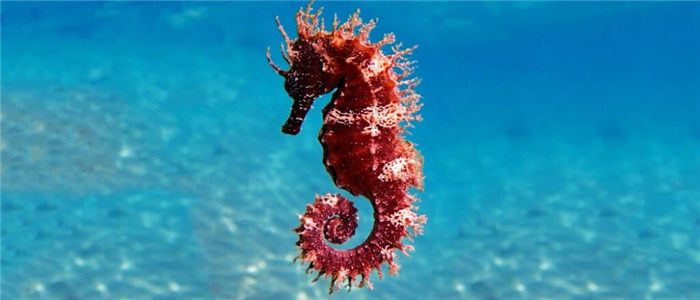
Adult seahorses can eat up to 50 times per day!
The seahorse is a relatively small animal, with the largest variety of them being about 12 inches long and the smallest of them being less than 1 inch long. They are also among the slowest fish in the ocean, so it would stand to reason that they do not require a lot of food.
Yet, the seahorse lacks a stomach within its digestive system, meaning it must constantly eat food to maintain its energy levels.
Seahorses must eat quite often. On average, they have to eat between 30 and 50 times per day. Although the amount that seahorses eat is relatively small, the fact remains that their frequent eating habits require a fair amount of hunting to keep their dietary needs met.
How Do Seahorses Hunt Food?
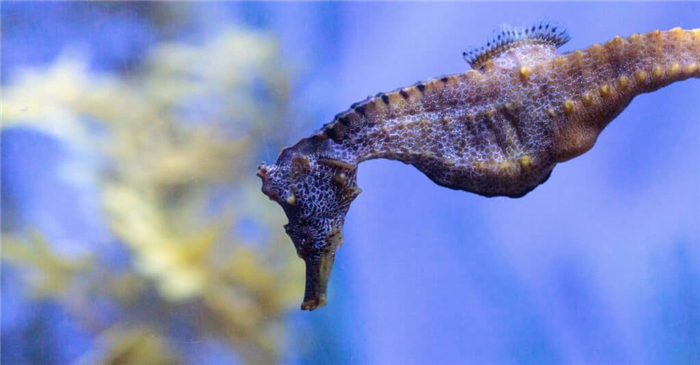
Seahorses use their great sight to identify prey and then suck them up with their snout.
Seahorses are very slow swimmers, and they are not very large fish, so hunting might seem almost impossible for them. However, they are adept at fulfilling their food requirements.
It all starts with their amazing sense of sight that they use to identify choice foods that suit their dietary needs. They can track small crustaceans that lack the senses to avoid them and then snatch them into their mouths using a vacuum force in their snout.
They would make for decent hunters if not for their poor mobility. As such, seahorses take another approach to finding the food they need. They use their prehensile tails to grip onto a stable anchor point like coral or another form of camouflage like vegetation. Afterward, they wait for food to float by before ambushing it and eating it.
The shape of their head helps when they spring forth at prey, giving these otherwise slow creatures the ability to claim a meal. The seahorse is not an incredibly cunning predator, but they are apparently very effective because many of them eat several dozen small shrimp each day.
What Do Baby Seahorses Eat?
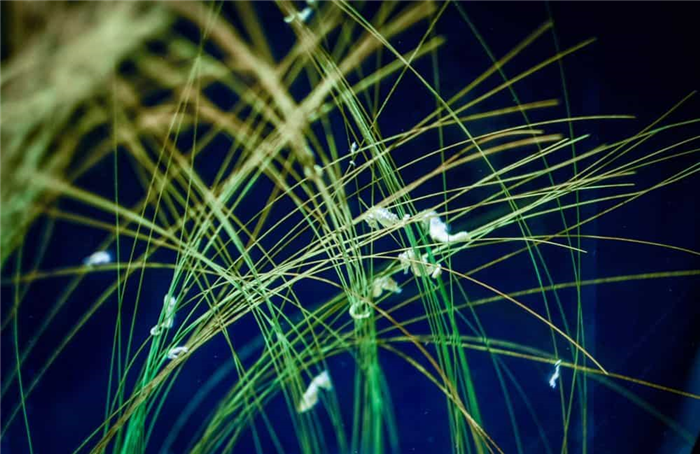
Baby seahorses eat small crustaceans like brine shrimp and copepods.
Nicole Griffin Ward/Shutterstock.com
Baby seahorses eat brine shrimp, rotifers, and other exceptionally small crustaceans. Like many other growing creatures, they have to eat a lot in their early lives.
A baby seahorse can consume a great deal of food, upwards of 3,000 small copepods during a 10 to 12-hour period. The number of creatures consumed is vast, but it’s important to consider two factors.
First, seahorses do not have stomachs, so babies need to eat a lot of food to get the nutrition they need to continue growing. Second, the size of these creatures is incredibly small, some as small as 11mm.
Seahorses will consume their prey whole, even as babies. They have no teeth, so they just suck the creature in through their snout and swallow.
All in all, baby seahorses eat a great number of various creatures while they are young, but they often fall victim to other creatures before reaching their full size. In fact, less than one in a thousand lives long enough to reach adulthood.
What Predators Eat Seahorses?
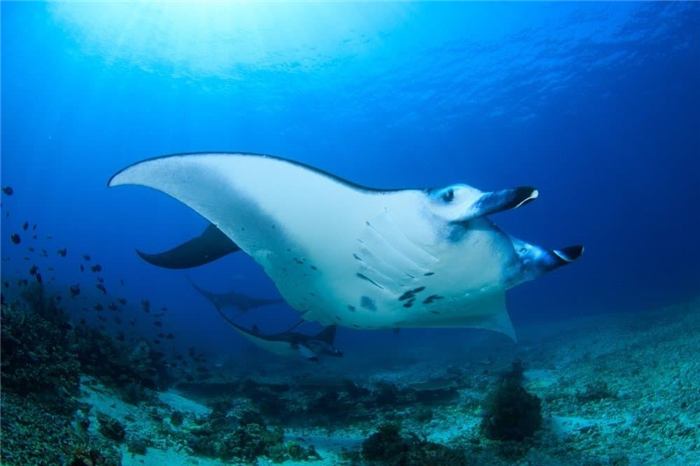
Manta rays can make quick work of seahorses.
As we have said, seahorses have many factors working against them in the ocean. They are among the slowest fish in the ocean, they have no defensive measures against actual predators, and if they get caught outside of cover, they are easy to pick off.
One thing they have working for them is their ability to camouflage themselves. They can use their shape, size, and color to blend into the background and keep themselves safe from any predators, especially those that rely upon their sight to hunt.
Nevertheless, seahorses are an easy meal for predators, even ones that are not that ambitious. As such, it’s common for seahorses to fall victim to a wide variety of creatures, including:
All these creatures are better adapted to attack than seahorses are to defend. As we’ve already mentioned, the vast majority of seahorses are killed as juveniles, but many are still killed as adults.
Interestingly, humans do not kill seahorses and eat them often, but they are considered a delicacy in some parts of the world. They also harvest them for medicinal uses. Currently, humans represent the greatest current threat to seahorse populations.
Seahorses are beautiful creatures that are hard to mistake in the ocean. They have a wide range around the world, bringing them into contact with many types of other fish, crustaceans, and other foods. Seahorses are small fish that have big appetites because of their digestive system, so they’re simultaneously some of the smallest fish but also the most frequent eaters.
One thing is for certain, these fish are very interesting, especially when you consider their eating and reproduction!
Share this post on:
Kyle Glatz
I’m a freelance writer with 8 years of experience. I’ve written in a variety of niches such as video games, animals, and managed service providers. I graduated from Rowan University in 2014 with degrees in English and Education. When I’m not working, I enjoy playing video games, reading, and writing for fun.
Special Feeding Adaptations of the Seahorse
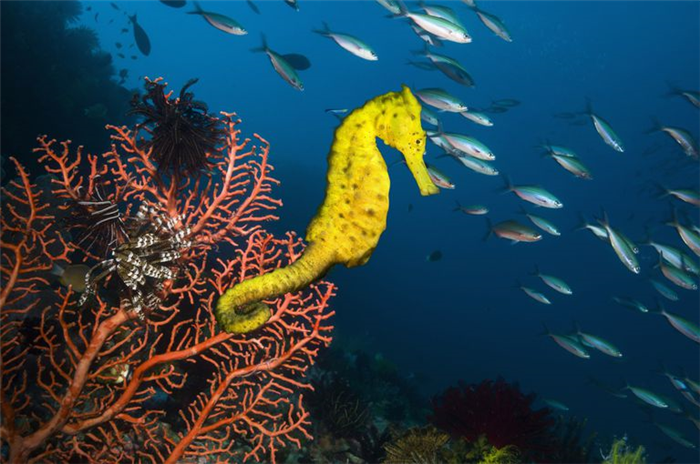
Jennifer Kennedy, M.S., is an environmental educator specializing in marine life. She serves as the executive director of the Blue Ocean Society for Marine Conservation.
The seahorse is one of 54 different species of fish in the marine genus Hippocampus—a word that comes from the Greek word for “horse.” Only a small handful of species are commonly seen in tropical and temperate waters of both the Pacific and Atlantic Oceans. They range in size from tiny, 1/2-inch fish to nearly 14 inches in length. Seahorses are one of the only fish that swim in an upright position and are the slowest-swimming of all fishes. Seahorses are generally considered to be an evolved form of pipefish.
How Seahorses Eat
Because they swim so slowly, eating can be a challenge for the seahorse. Further complicating things is the fact that a seahorse has no stomach. It needs to eat almost constantly because food quickly passes straight through its digestive system. An adult seahorse will eat 30 to 50 times per day, while baby seahorses eat 3,000 pieces of food per day.
Seahorses do not have teeth; they suck in their food and swallow it whole. Thus their prey needs to be very small. Primarily, seahorses feed on plankton, small fish and small crustaceans, such as shrimp and copepods.
To compensate for its lack of swimming speed, a seahorse’s neck is well adapted for catching prey. Seahorses ambush their prey by hovering silently nearby, attached to plants or corals and often camouflaged to blend in with their surroundings. Suddenly, the seahorse will tilt its head and slurp in its prey. This movement results in a distinctive sound.
Unlike their relatives, the pipefish, seahorses can extend their heads forward, a process that is aided by their curving neck. Although they can’t swim as well as pipefish, The seahorse has the ability to stealthily reach out and strike their prey. This means that they can wait for prey to pass by their perch, rather than actively pursuing them—a task that is difficult given their very slow speed. The hunt for prey is also aided by the seahorse’s eyes, which have evolved to move independently, allowing them an easier search for prey.
Seahorses as Aquarium Specimens
What about captive seahorses? Seahorses are popular in the aquarium trade, and there is currently a movement to raise seahorses in captivity to protect the wild population. With coral reefs in danger, the native habitat of the seahorse is also challenged, leading to ethical concerns about harvesting them from the wild for the aquarium trade. Further, captive-bred seahorses seem to thrive better in aquariums than do capture wild seahorses.
However, efforts to breed seahorses in captivity is somewhat complicated by the fact that young seahorses prefer live food that must be very small, given the tiny size of the young seahorses. While they are often fed frozen crustaceans, captive seahorses do better when feeding on live food. Live wild- or captive-raised copepods (tiny crustaceans) and rotifers are a good food source that allows young seahorses to thrive in captivity.
Know What do Seahorses Eat
Something very intriguing about seahorses is, that every one of them has a kind of Crown on their head, which is different for each specie, none resembles the other, which is something amazing. It is necessary that you learn and know a little more about the characteristics of the freshwater seahorses.
We know a little more about seahorses, now it is time to know What do Seahorses Eat
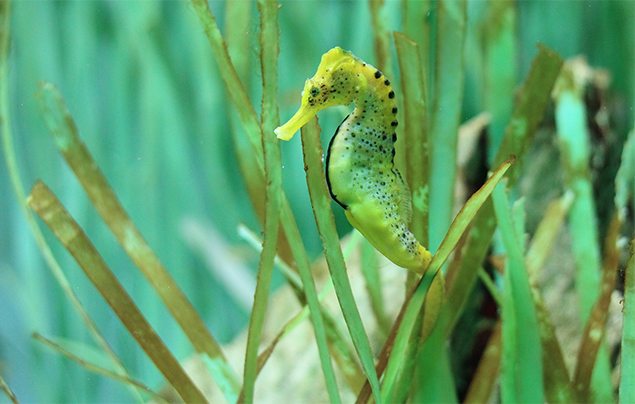
What do They Eat?
The biggest portion of seahorse’s diet , is based mostly in the consumption of shrimps, plankton (tiny organisms floating in salt water), and crustaceans. They don’t have teeth, thus they have to eat their prey entire .
Having eyes with independent movement, allows to recognize the perfect snack for them. It should be noted that small crustaceans constitute the main portions of seahorses’ alimentation
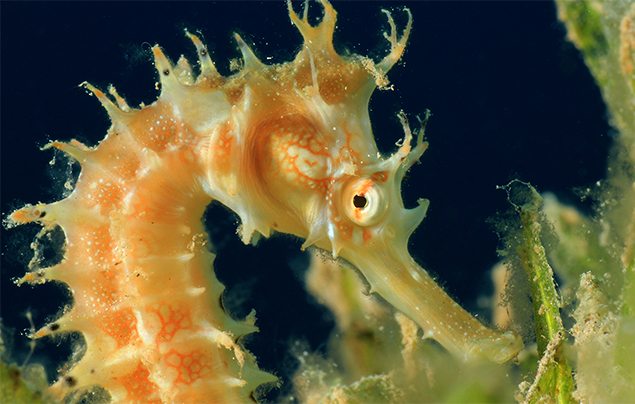
The large snout they possess, helps them eat with ease and slowly, thus ., they can spend much of the time eating, in order to enjoy their snacks.
As creatures that can be incorporated seamlessly with the environment, they take advantage of this ability to wait calmly and unnoticed the arrival of their food.
When a seahorse has its prey, it is almost impossible that it can escape, that is to say, they can eat and enjoy their food slowly, as they tend to do.
A very interesting characteristic of seahorses, is that they have no stomach, this is the reason why they eat almost all the time, its digestion occurs immediately after eating. This answers to the concerns of many people about seahorses.
